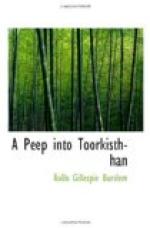[* Note: Tomaun, twenty rupees or about L2.]
All necessary preparations for the departure being now completed, the camel destined for the accommodation of the invalid was brought to the door of the palace, conducted by a favourite Arab who had for many years filled the office of head Surwan or camel-driver. The colour of the animal was almost white, and the large gold embroidered housings swept the ground; on either side was fixed a wicker-basket lined and covered with red cloth, and furnished with soft cushions; one of these held the young Kh[=a]n, whilst the other was occupied by the nurse who was the original promoter of the expedition. At length the word to march was given, and the escort consisting of sixty horsemen galloped forth. Khan Shereef himself was clad in a coat of mail, and wore a circular steel head-piece, in which were three receptacles for as many heron plumes; a light matchlock, the barrel of which, inlaid with gold, was slung across his shoulder; attached to his sword-belt were the usual priming and loading powder-flasks made of buffalo’s hide, with tobacco-pouch and bullet-holder of Russia leather worked with gold thread; and the equipment was completed by the Affgh[=a]n boots drawn up over the loose trousers reaching to the knee, with sharp-pointed heels serving for spurs.
The procession moved on, the escort forming an advance and rear-guard, the chief galloping sometimes in front of the party, and now walking his Toorkm[=a]n steed alongside the richly caparisoned camel with its precious burthen.
Occasionally a horseman would dash out from the ranks in chace of a wild goat or sheep crossing the little frequented road, or, dismounting and giving his horse in charge of a comrade, would make a detour on foot in the hope of getting a shot at a chichore.[*] The tedious hours of march were thus wiled away till they reached the “Dundun Shikkun Kotul” or tooth-breaking pass, when the horsemen assumed a more steady demeanour. They were now within forty miles of the celebrated spring, which they hoped to reach on the following day.
[* Note: This is a species of partridge very abundant throughout Toorkistan.]
The Dragon’s Mouth is situated four or five miles to the north-west of Bamee[=a]n, high up in the mountains in the direction of the Yookaoolung country. After a toilsome and somewhat perilous ascent the traveller finds himself at the edge of a deep ravine—or rather fissure in the rock, for the width at the top is seldom more than twelve feet—the sides presenting a ferruginous appearance, with tints varying from extremely dark to lighter shades, by reason of the soil being so strongly impregnated with ore. The low gurgling of the wonder-working stream might be heard issuing from the depths of the dark abysm.
Below, and at the only point of feasible approach for the disease-stricken, is a large cave, where the water bubbles up warm, and forming innumerable small whirlpools before it breaks again into a stream, and mingles its waters with those of a torrent below.




